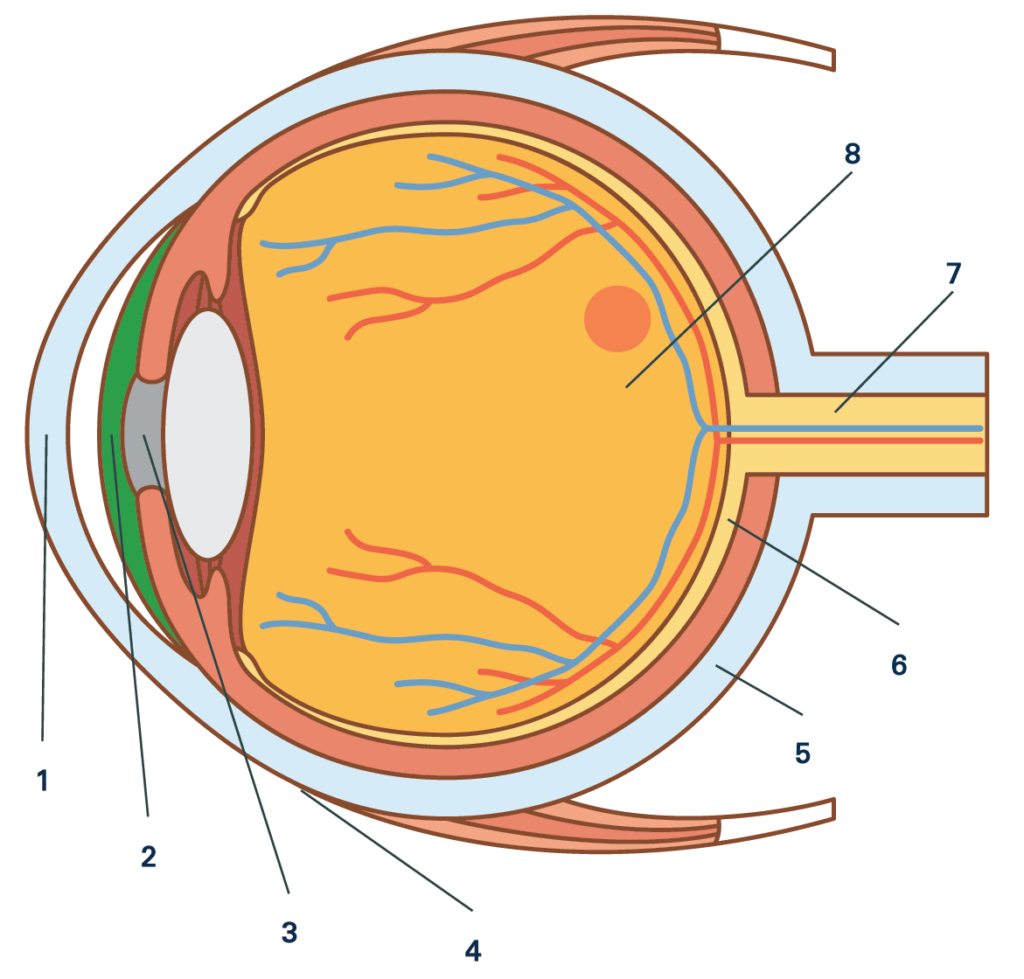Your eyes say more about you than you may realize, especially as you age. Learn about each part of your eye and how they can change over time.

- The Cornea is the transparent, front part of the eye. It is dome-shaped and is responsible for focusing light that enters the eye.
- As you age: The cornea’s curvature, diameter, and thickness change.
- Talk to your eye doctor if: You’re experiencing clouded vision, swelling of the cornea, and inability to focus on objects near you. These symptoms could be due to dry eye disease or glaucoma.1, 2, 3
- The Iris is the colored part of the eye which dilates and constricts to control the amount of light that enters the pupil – the small black circle in the center of the iris.
- As you age: The pupil tends to shrink and the iris becomes less reactive, making it more difficult to dilate and adjust to light.
- Talk to your eye doctor if: Activities like reading are becoming more difficult. This could be a result of the eye taking in less light. People in their 60s need three times more light for comfortable reading than those in their 20s.4,5
- The Lens is located directly behind the pupil, it changes shape as your eyes focus on things close-up or far away.
- As you age: The lens loses elasticity, which often results in presbyopia, which makes focusing on close-up objects more difficult. Presbyopia can be treated by using bifocals to correct vision.
- Talk to your eye doctor if: You’re experiencing blurred vision, poor vision at night, colors appearing faded, or an increased sensitivity to bright lights – these symptoms could be the result of cataracts, an eye disease causing the lens to become cloudy.6,7
- The Conjunctiva is a thin, clear tissue covering the surface of the eye and the inner surface of the eyelids.
- As you age: When the conjunctiva becomes inflamed, it’s referred to as conjunctivitis or “pink eye.”
- Common symptoms of this condition include itching, discharge, discoloration, and redness. If you’re experiencing any of these symptoms, visit your eye doctor for treatment.8
- The Sclera is the rigid, “white” of the eye which is located directly underneath the conjunctiva. It covers almost all the surface of the eye and is the principal protective structure for the eye.
- As you age: The sclera tends to become thinner, denser, and more rigid due to dehydration and calcification.
- Talk to your eye doctor if: You notice gray spots on the sclera, these could be calcium deposits. However, it is rare for them to cause irritation or infection.9,10,11
- The Retina is the layer lining the back part of the eye. It is what allows us to see by sensing light and sending signals to the brain.
- As you age: The number of cells responsible for sending visual stimuli to the brain decreases.
- Talk to your eye doctor if: You’re having difficulty focusing on objects close-up, difficulty distinguishing the distance of objects, and increased adjustment time between darkness and light.12,13
- The Optic Nerve is located at the rear of the eye and conducts visual information to the brain.
- As you age: There is a decrease in the number of optic nerve axons, an increase in thickness of the connective tissue of the optic nerve, and an increased number of elastic fibers – which can all lead to difficulty focusing on objects close to you.
- Talk to your eye doctor if: You’re experiencing “blind spots” in your vision, faded colors, and a slower reaction to light. This could be due to atrophy to the optic nerve, caused by poor blood flow or glaucoma.14,15,16
- The Vitreous is the jelly-like fluid that fills the eye and contains fibers that attach to the retina.
- As you age: Vitreous fluid condenses and it’s common for the fibers within the vitreous to dislocate from the retina, causing a condition called vitreous detachment.
- Talk to your eye doctor if: You’re experiencing a sudden increase in floaters or flashes of light in your peripheral vision. Most cases do not require treatment, but if you’re experiencing these symptoms, you should visit your eye doctor.17,18,19
Sources
- Scientific Reports, Vitályos, G., Kolozsvári, B.L., Németh, G. published 3/04/19, accessed 5/3/23
- Cleveland Clinic, reviewed by a Cleveland Clinic medical professional on 11/23/2020, accessed on 5/3/23
- National Library of Medicine, Renata Vaiciuliene, Neda Rylskyte, Gabija Baguzyte, and Vytautas Jasinskas published 2/23/22, accessed on 5/3/23
- 20/20 Onsight, Dr. Doug Haigh, published 5/10/18, accessed 5/3/23
- National Library of Medicine, Galo Apolo, Naim Lazkani, Sarah Zhou, Abe E. Song, Anmol A. Pardeshi, Lernik Torossian, Kent Nguyen, Robert N. Weinreb, and Benjamin Y. Xu, published on 11/14/22, accessed on 5/3/23
- Merick Manual, full review/revision Mar 2022 by James Garrity, MD, accessed on 5/3/23
- National Eye Institute, U.S. Department of Health and Human Services, updated 1/13/23, accessed 5/3/23
- American Academy of Ophthalmology, Luis Ignacio Larrazabal M.D., reviewed by Sarah Brown Weissbart, MD on 4/11/22, accessed on 5/3/23
- American Academy of Ophthalmology, Kierstan Boyd, published 9/9/22, accessed 5/3/23
- American Academy of Ophthalmology, Eric Lane Crowell, MD, MPH, Vatinee Y. Bunya, MD, MSCE, Christina Moon, M.D., Subahari Raviskanthan, MBBS, reviewed by Christina Moon, M.D. on 4/19/23, accessed on 5/3/23
- Cleveland Clinic, reviewed by a Cleveland Clinic medical professional on 11/12/2021, accessed on 5/3/23
- Medical News Today, medically reviewed by Grace Zhang, MD, Rachel Ann Tee-Melegrito on 11/10/21, accessed on 5/3/23
- National Library of Medicine, Surabhi Ruia & Evan J. Kaufman, last updated on 8/3/22, accessed on 5/3/23
- MDPI, Janet Coleman-Belin, Alon Harris, Bo Chen, Jing Zhou, Thomas Ciulla, Alice Verticchio, Gal Antman, Michael Chang, Brent Siesky, published on 1/29/23, accessed on 5/3/23
- MDPI, Deniz Goodman, Steven Ness, published on 3/20/23, accessed on 5/3/23
- Medline Plus – A.D.A.M. Medical Encyclopedia, reviewed on 8/22/22 by Franklin W. Lusby, MD, David C. Dugdale, MD, Brenda Conaway and the A.D.A.M. Editorial team. Accessed on 5/3/23
- Medical News Today by Mathieu Rees, medically reviewed by Vicente Diaz, MD on 11/8/22, accessed on 5/3/23
- National Eye Institute, U.S. Department of Health and Human Services, updated on 9/8/20, accessed on 5/3/23
- National Institute on Aging, medically reviewed on 7/28/21, accessed on 5/3/23

